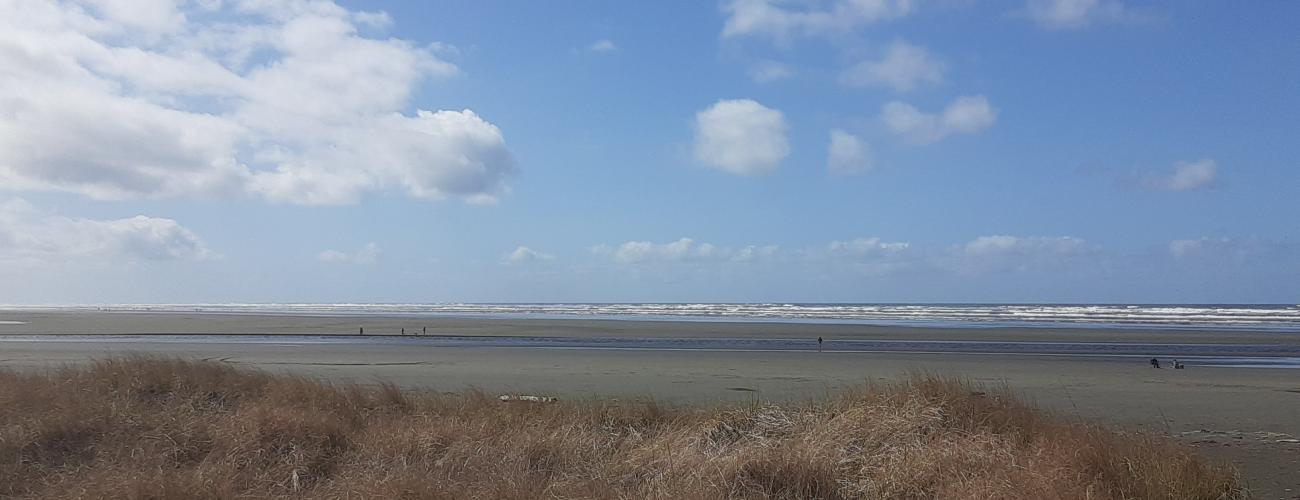Pacific Beach State Park History
Pacific Beach State Park has a long history as a place for travelers to rest as they journey along Washington’s Pacific Ocean coastline.
Indigenous Lands
The park lies within the traditional territories of Coast Salish Indigenous people whose present-day descendants include members of the Quinault Indian Nation and the Confederated Tribes of the Chehalis Reservation.
Ethnographers reported that the mouth of Joe Creek in today’s Pacific Beach State Park served as a “rest stop” for Indigenous people traveling along the coast between trading centers.
Local tribes ceded ownership of the area to the US federal government under duress in the Treaty of Quinault River in 1855, keeping rights to harvest natural resources in their usual and accustomed places including the beaches and waters of the Pacific Ocean coast.
Other local tribes refused to accept the conditions proposed by Washington Territorial Governor Isaac Stevens at the Chehalis River Treaty Council in February 1855. Subsequently, title to the land was relinquished to the US federal government and the Chehalis Reservation was established by executive order of Secretary of the Interior J. P. Usher on July 8, 1864.
Land Distribution
The US government survey of the area was completed in 1893, and most of the land in today’s Pacific Beach State Park passed into private ownership as a Homestead Entry patent, “proved up” with the required construction of a dwelling and farm development by Magnus Hokanson in 1897.
His neighbor to the north, Henry Blodget, proved up his homestead in 1896, including the land where today’s park welcome center sits.
Like many other homesteaders on the Washington coast, the Hokansons and Blodgets sold their patented land, moving on to other opportunities. The land was owned by the Hoquiam Timber Company by 1919.
Vacation Destination and Secret Listening Post
Construction of the Northern Pacific Railroad spur line through the community of Pacific Beach in the early 1900s made access to the area very easy, and it soon became popular as a tourist destination. In 1911, Carl A. Cooper purchased the Pacific Beach Hotel, which had been built on the former Blodget homestead. Cooper promoted it as a vacation destination. After a fire destroyed the aging building in 1914, Cooper rebuilt a modern hotel that became a year-round destination.
Wartime travel and gasoline purchase restrictions curtailed vacationing at Pacific Beach during World War II. The US Navy identified the hotel as an “underused facility” that could be easily converted to military use and acquired the property. In 1942, the US Navy opened an anti-aircraft-gunnery training facility in the remodeled hotel. Trainees practiced firing at targets towed by airplanes flying along the coastline. For safety, the waters were closed to all vessels within nine miles of the shoreline at Pacific Beach.
After closure of the training facility in 1945, the property remained unused until 1948, when an Air Force Radar Station was established on the site to close a gap in aircraft detection capability on the Washington coast. When permanent facilities were built elsewhere, the station was closed in 1952.
In 1958, the US Navy commissioned a classified Sound Surveillance System (SOSUS) station on the site. It was publicly identified as a navy oceanographic research facility to shield its secret use as a listening post with hydrophones on the seafloor detecting the sounds of Soviet nuclear missile submarines. Triangulation of data from the Pacific Beach station with other SOSUS stations in Oregon, California and Guam allowed operators to pinpoint the location and movements of submarines.
During the period the SOSUS station operated, the old Pacific Beach Hotel building was replaced by the station commander’s house, and the former resort cottages were converted to family housing.
The SOSUS station was decommissioned in 1987, and the facility was repurposed as a recreation and conference center for active and retired service members, Department of Defense employees and their families.
Taking advantage of renewed travel to Pacific Beach as a vacation destination, Norman and Helen Ross developed Ross Campground near the mouth of Joe Creek, just south of the Pacific Beach SOSUS station by the early 1970s.
Creating a State Park
The Washington State Parks and Recreation Commission (WSPRC) prioritized acquisition of public access to ocean beaches. The WSPRC affirmed its desire to purchase the Ross Campground property at Pacific Beach in August 1971.
With funding approved by the Interagency Committee for Outdoor Recreation (now called the Recreation and Conservation Office), a state agency created in 1964 by voter approval of a citizen’s initiative, the WSPRC purchased the Ross Campground property on January 31, 1972.
The Rosses continued to operate the campground under a concession agreement with the WSPRC, and others continued the campground concession from 1973 until 1990.
Additional properties on both the former Hokanson and Blodgett homestead lands were acquired by the WSPRC from 1973 through 1989, expanding the campground and day use recreation opportunities at the park.
Sharing the histories of Washington’s state parks is an ongoing project. Learn more here.

